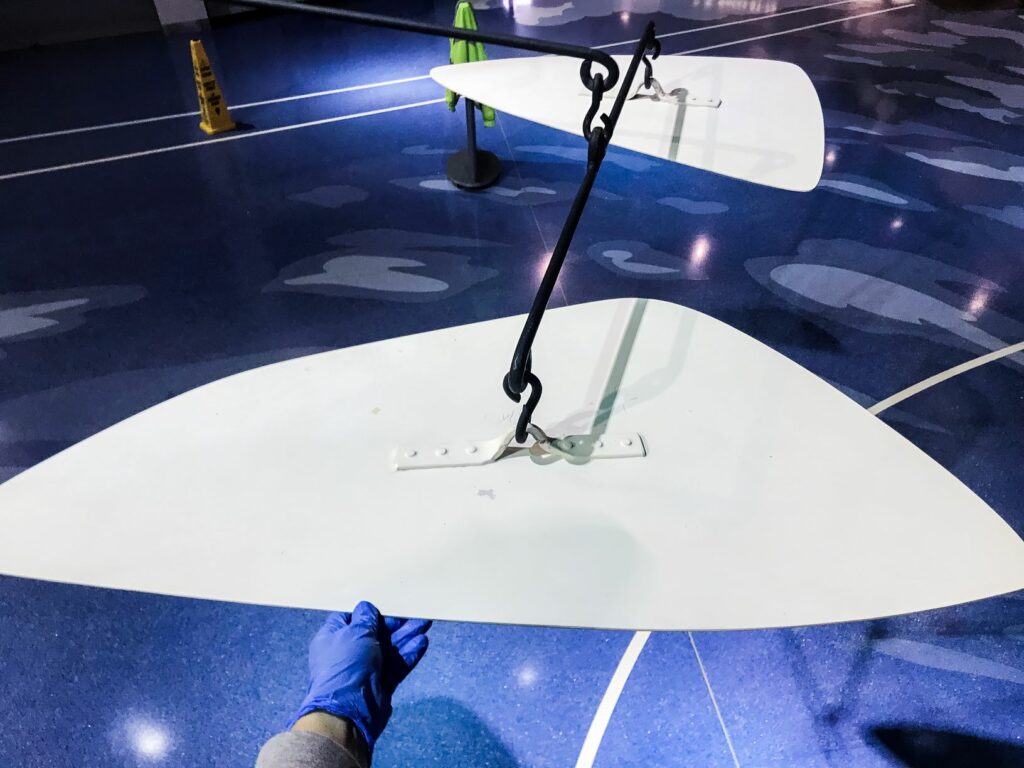Careful Conservators Keep Classic ‘Pittsburgh’ Clean
Mobile by famed artist Alexander Calder is star of airport’s art collection
By Matt Neistei
Published January 4, 2021
Read Time: 3 mins
Christina Simms has a tried-and-true plan to clean up Pittsburgh.
Microfiber cloths.
To be clear, Simms focuses on cleaning up Pittsburgh, the iconic kinetic sculpture by famed artist Alexander Calder that hangs in the Airside Center Core in Pittsburgh International Airport.
An objects conservator with Ohio-based McKay Lodge Art Conservation Laboratory, Simms visits the airport once a year to clean and care for the huge mobile that slowly twists in the air currents above passengers’ heads.
Although Pittsburgh, like its namesake city, has gone through different looks over the years, it was returned to its intended black and white paint job before being hung in the terminal, and Simms is dedicated to keeping it pristine.
“Calder was very specific in using a matte paint for pretty much every one of his sculptures, and this one is no exception,” she said.
In late October, Simms spent a couple of nights up on a hydraulic lift in an area roped off by airport staff. With the help of an assistant who held the sculpture steady, Simms gently wiped down the white panels and black rods, cleaning off dust and any other debris that might have settled on the artwork in the preceding year.
The microfiber prevents the paint from becoming burnished, Simms said, adding that Pittsburgh’s coating is in good shape.
History of Pittsburgh
The aluminum and steel sculpture was hung in Greater Pittsburgh Airport in 1959 after it won first prize at the Carnegie Institute’s 1958 Bicentennial International Exhibition of Contemporary Art. It was placed in its current location at Pittsburgh International Airport’s airside terminal center core in 1992.

Objects conservator Christina Simms visits PIT annually to clean and care for Calder’s mobile. (Photo courtesy of Christina Simms)
The mobile has traveled to exhibitions around the world over the years to places like England and the famed Guggenheim Museum Bilbao in Spain. But it always returns home to the airport, where it remains the star centerpiece of the Allegheny County Airport Authority’s arts and culture collection, said manager Rachel Rearick.
“I like to think of it as a visual statement which showcases the direction of our airport and our region,” she said. “When this piece was made, Calder’s work was a wonder of abstract balance and imagination, and thanks to our leadership at PIT, we are continually making innovative strides that guide industry standards.”
A third-generation sculptor, Calder was born in Lawnton, Pa., and lived in the Philadelphia area during his early childhood. He received international acclaim for much of his career, and appreciation for his work grew over the decades—both in esteem and dollar signs. Now his art can sell for tens of millions of dollars.
Calder created an extensive amount of public sculpture that can be found worldwide, and his work is also on display in galleries such as the Whitney Museum of American Art, the Solomon R. Guggenheim Museum and the Museum of Modern Art, all in New York City; the Centre Georges Pompidou, Paris; the Museo Nacional Centro de Arte Reina Sofía, in Madrid; and the National Gallery of Art in Washington, D.C.
Watch
This Next
Read
This Next





